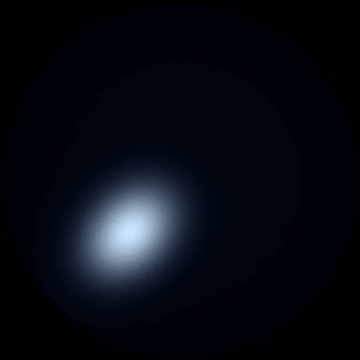Water reflectivity and the color of the EarthDid you ever wonder where the blue ocean gets its color from? Of course you can answer this question with libRadtran! All you need to do is calculate radiances at TOA for a number of angles (umu,phi) using output rgb to calculate colors instead of radiances, and plot the data. The ocean surface is treated with the parameterization by Cox and Munk [1954] and Nakajima et al. [1983]: cox_and_munk_u10 5 The ocean reflectivity is mainly determined by the wave height which is determined by the wind speed, 5 m/s in this example. The following picture shows a fish-eye view in nadir direction: The most important feature is the specular reflection. The size of this so-called “sun glint” is determined by the wind speed: the lower the wind speed, the smaller and brighter the sun glint. Outside the sun glint, the ocean appears in deep blue. Now we switch off Rayleigh scattering no_rayleigh and obtain the following: All the blue is gone. This clearly illustrates that the blue color of the ocean has nothing to do with wavelength-dependent reflectivity of the water surface, but is simply caused by the reflection of diffuse Rayleigh-scattered skylight (plus Rayleigh scattering of the reflected direct sun) by the ocean surface. In fact, we have three contributions:
(plus an infinte number of higher-order processes, of course). In order to separate those contributions, we may do two things: First, calculate Rayleigh scattering over a black surface which is exactly contribution number 1. Second, calculate the picture again including Rayleigh scattering and ocean reflectivity, but this time directly at the surface rather than at top-of-atmosphere which is exactly contribution number 2. Contribution number 3 cannot be calculated without a modification of source code. The following picture shows contributions 1 (left) and 2 (right), calculated as described here: Both contributions are relevant for the result, but it appears that the direct atmospheric contribution is actually higher than the reflection of the atmosphere by the ocean surface, except at the edges. This has probably to do with the fact that the reflectivity of clean water is generally very small, except for low incidence or reflection angles. This calculations were done immediately after a Christmas party of the ESPACE Master's Program at the Technical University of Munich where Prof. Ulrich Walter reported about his experiences in space during the STS-55 Mission (aka D-2 Mission) and showed many exciting pictures of the Earth taken from space. We were wondering where the blue color of the Earth comes from and after a few cups of Gluehwein these calculations were made (yes, libRadtran is really that easy to use!). As an experimental confirmation, Ulrich Walter provided this picure taken from the International Space Station which is remarkably close to the simulation. Well, except for the clouds, and I guess without the Gluehwein we would have been able to even include the clouds in the calculation: |



